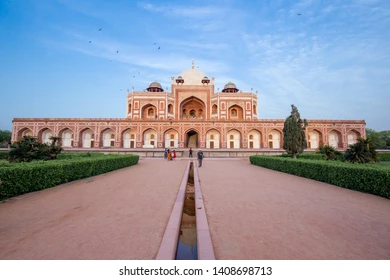Context:
Union Minister of Culture and Tourism, inaugurated the Humayun’s Tomb World Heritage Site Museum at the Humayun’s Tomb, in New Delhi.
Humayun’s Tomb Museum
- It is a facility of the Archaeological Survey of India designed and built in collaboration with the Aga Khan Trust for Culture (AKTC). The foundation stone of the Museum was laid in April 2015
- It is a UNESCO recommendation that interpretation centres/site museums be provided at the entrance zone of significant World Heritage Sites to provide the cultural context of the heritage site
- Its architecture is inspired by the ancient ‘Baolis’ or stepped wells of Delhi.
- The museum houses over 500 exquisite artifacts, providing invaluable insights into Emperor Humayun’s life and the rich cultural tapestry of the era.
Museum Galleries
- The first principal Gallery, ‘Where the Emperor Rests’, is focused on the architecture of Humayun’s Mausoleum and the personality of Emperor Humayun.
The gallery, ‘Icons of a Sacred Landscape’, has exhibits focused on the four iconic cultural personalities.
- Hazrat Nizamuddin Auliya: Sufi Saint.
- Amir Khusrau: created the Qawwali music genre.
- Rahim: commander-in-chief of Akbar’s army.
- Dara Shukoh: translated the Upanishads into Persian.
Archaeological Survey of India (ASI)
- ASI is under the Ministry of Culture and is the premier organization for archaeological researches and protection of the cultural heritage of the nation.
- Maintenance of ancient monuments and archaeological sites and remains of national importance is the prime concern of the ASI.
- Besides, it regulates all archaeological activities in the country as per the provisions of the Ancient Monuments and Archaeological Sites and Remains Act, of 1958. It also regulates the Antiquities and Art Treasure Act, 1972.
Aga Khan Trust for Culture (AKTC)
- Aga Khan, the founder and chairman of the Aga Khan Development Network (AKDN), is the 49th hereditary Imam (Spiritual Leader) of the Shia Imami Ismaili Muslims.
- It is dedicated to improving the quality of life of those in need, mainly in Asia and Africa, irrespective of their origin, faith, or gender.
Significance of the museum
- This museum embarked on the historic extension of ‘Indraprastha’ the capital of the Pandavas in the epic Mahabharata on the bank of Yamuna.
- It echoes the Prime Minister’s vision, the amalgamation of development as well as heritage – “Vikas bhi Virasat bhi”.
- The museum will significantly enhance the visitor experience by providing an understanding of the Outstanding Universal Value of this ensemble that includes monumental buildings built from the 14th to the 19th century.
Humayun’s Tomb
- It was built in 1569-70, fourteen years after the death of Humayun, by his senior widow Bega Begam.
Humayun was the second Mughal ruler of India, he was the son and successor of Babur, who had founded the Mughal dynasty. - It was the first garden-tomb on the Indian subcontinent.
- The tomb itself is in the centre of a large garden, laid out in char baah (four-fold) style, with pools joined by channels.
- Humayun’s garden-tomb is also called the ‘dormitory of the Mughals’ as in the cells are buried over 150 Mughal family members.
- Mirak Mirza Ghiyath, a Persian, was the architect of this tomb.
- It was declared a UNESCO World Heritage Site in 1993.

